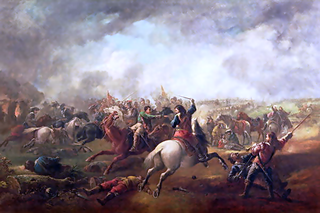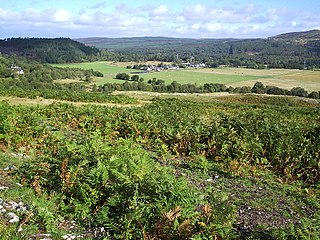Related Research Articles

The Battle of Marston Moor was fought on 2 July 1644, during the First English Civil War of 1642–1646. The combined forces of the English Parliamentarians under Lord Fairfax and the Earl of Manchester and the Scottish Covenanters under the Earl of Leven defeated the Royalists commanded by Prince Rupert of the Rhine and the Marquess of Newcastle.

John Campbell, 1st Earl of Loudoun was a Scottish politician and Covenanter.

Archibald Campbell, 1st Marquess of Argyll, 8th Earl of Argyll, Chief of Clan Campbell was a Scottish nobleman, politician, and peer. The de facto head of Scotland's government during most of the conflict of the 1640s and 50s known as the Wars of the Three Kingdoms, he was a major figure in the Covenanter movement that fought for the maintenance of the Presbyterian religion against the Stuart monarchy's attempts to impose episcopacy. He is often remembered as the principal opponent of the royalist general James Graham, 1st Marquess of Montrose.

The Battle of Dunbar was fought between the English New Model Army, under Oliver Cromwell, and a Scottish army commanded by David Leslie, on 3 September 1650 near Dunbar, Scotland, and was decisively won by the English. It was the first major battle of the Third English Civil War, which was triggered by Scotland's acceptance of Charles II as king of Britain after the beheading of his father, Charles I on 30 January 1649.

The 1648 Second English Civil War is one in a series of connected conflicts in the kingdoms of England, incorporating Wales, Scotland, and Ireland. Known collectively as the 1638 to 1651 Wars of the Three Kingdoms, others include the Irish Confederate Wars, the 1638 to 1640 Bishops' Wars, and the Cromwellian conquest of Ireland.

The Third English Civil War (1650–1651) was the last of the English Civil Wars (1642–1651). It consisted primarily of an invasion of Scotland by an English army controlled by the Rump Parliament and commanded by Oliver Cromwell and a subsequent Scottish invasion of England by a Scottish army loyal to King Charles II and commanded by David Leslie. It ended after 14 months with Scotland conquered and garrisoned by the English, Charles in exile abroad, the English Parliament in control of the British Isles and Cromwell as the most influential man in the new Commonwealth.

Between 1639 and 1653, Scotland was involved in the Wars of the Three Kingdoms, a series of wars starting with the Bishops Wars, the Irish Rebellion of 1641, the English Civil War, the Irish Confederate Wars, and finally the subjugation of Ireland and Scotland by the English Roundhead New Model Army.

The Engagers were a faction of the Scottish Covenanters, who made "The Engagement" with King Charles I in December 1647 while he was imprisoned in Carisbrooke Castle by the English Parliamentarians after his defeat in the First Civil War.

The Battle of Inverkeithing was fought on 20 July 1651 between an English army under John Lambert and a Scottish army led by James Holborne. It was a part of the English Invasion of Scotland during the Third English Civil War. The battle was fought near the isthmus of the Ferry Peninsula, to the south of Inverkeithing, after which it is named.

Archibald Johnston, Lord Wariston was a Scottish judge and statesman.

The Battle of Carbisdale took place close to the village of Culrain, Sutherland, Scotland on 27 April 1650 and was part of the Wars of the Three Kingdoms. It was fought by the Royalist leader James Graham, 1st Marquess of Montrose, against the Scottish Government of the time, dominated by Archibald Campbell, 1st Marquess of Argyll and a grouping of radical Covenanters, known as the Kirk Party. The Covenanters decisively defeated the Royalists. The battlefield has been inventoried and protected by Historic Scotland under the Scottish Historical Environment Policy of 2009. Although Carbisdale is the name of the nearest farm to the site of the battle, Culrain is the nearest village.

The Battle of Hieton was a skirmish fought on the 1 December 1650 between a Covenanter party and an English garrison. The site of the battle was by the Cadzow Burn, near the present day town centre of Hamilton, Scotland.

The 1639 and 1640 Bishops' Wars were the first of the conflicts known collectively as the 1638 to 1651 Wars of the Three Kingdoms, which took place in Scotland, England and Ireland. Others include the Irish Confederate Wars, the First, Second and Third English Civil Wars, and the Cromwellian conquest of Ireland.

The Battle of Mauchline Muir was an engagement fought on 12 June 1648 between two rival factions of the Covenanters of Scotland. On one side where those who favoured The Engagement, known as Engagers, and those who were opposed to the Engagement, and known as the Kirk party.
Archibald Strachan was a Scottish soldier who fought in the Wars of the Three Kingdoms, reaching the rank of Colonel.
The Western Remonstrance was drawn up on 17 October 1650 by Scotsmen who demanded that the Act of Classes (1649) was enforced and remonstrating against Charles, the son of the recently beheaded King Charles I, being crowned King of Scotland. It was presented to the Committee of Estates by Sir George Maxwell, at Stirling, on 22nd of that month. Those who supported the Remonstrance are known as Remonstrants of Remonstraters.

James Guthrie, was a Scottish Presbyterian minister. Cromwell called him "the short man who would not bow." He was theologically and politically aligned with Archibald Johnston, whose illuminating 3 volume diaries were lost until 1896, and not fully published until 1940. He was exempted from the general pardon at the restoration of the monarchy, tried on 6 charges, and hanged in Edinburgh.
Captain William Govan (1623–1661). was a Scottish officer who fought for the Covenanters during the Wars of the Three Kingdoms. He was awarded the honour of presenting Montrose's standard to the Scottish Parliament in 1650. He was accused of deserting the Scottish army later the same year and supporting the English New Model Army under the command of Oliver Cromwell, which was at that time invading Scotland. On 1 June 1661, the year after the restoration of the monarchy, and a few days after he was found guilty of treason, he was hanged as a traitor next to the Mercat Cross in Edinburgh and his head was put on a spike and displayed at West Port, Edinburgh.
John Swinton (1621?–1679) was a Scottish politician active during the Wars of the Three Kingdoms and during the Interregnum. At the Restoration he was found guilty of treason and was imprisoned for some years before being released. In later life be became a Quaker.
Colonel John Cockburn was an officer in the Scottish Covenanter army in the late 1640s and early 1650s during the Wars of the Three Kingdoms. In this capacity he led Lowland soldiers against Montrose's Scottish Royalist forces during the First English Civil War (1642-1646), when the Covenanter parliament of Scotland was allied with the English Parliamentarians against King Charles I. Colonel Cockburn led the colourfully defiant but futile Scottish resistance at Hume Castle during the Third English Civil War (1649-1651), when a Parliamentary army led by Oliver Cromwell invaded Scotland after its Covenanter government had made an uneasy alliance with King Charles II.
References
- Baillie, Robert; Aiken, Robert (translator) (1775). Letters and Journals: Containing an impartial account of public transactions, Civil, Ecclesiastic, and Military, both in England and Scotland, from 1637 to 1662; a period, perhaps, the most remarkable that is to be met with in the British History : With An Account of the Authors's Life ... 2. Gray. pp. 364, 365.
- Browne, James (1851). A history of the Highlands and of the Highland clans. 2. A. Fullarton. p. 67.
- Buchanan, George (1829). The history of Scotland: with notes, and a continuation to the present time (six volumes). 4. Translated by Aikman, James. Ireland. p. 416.
- Furgol, Edward M. (1990). A regimental history of the covenanting armies, 1639-1651. J. Donald Publishers. ISBN 978-0-85976-194-9.
- Furgol, Edward M. (2004). "Strachan, Archibald (d. 1652)". Oxford Dictionary of National Biography. Oxford University Press. doi:10.1093/ref:odnb/26617.
- Mitchison, Rosalind (2002). A history of Scotland (3, illustrated ed.). Routledge. p. 238. ISBN 0-415-27880-5.
- Scottish History Society (1994). Miscellany of the Scottish History Society. Printed at the University Press by T. and A. Constable for the Society. p. 81. ISBN 978-0-906245-16-3.
Colonels Ker, Archibald Strachan, and Robert Halket
- Wodrow, Robert (1828). Burns, Robert (ed.). The history of the sufferings of the church of Scotland from the restoration to the revolution. 1. Edinburgh: Blackie, Fullarton & co., and A. Fullarton and Company. pp. 195–196.
Attribution
-
 This article incorporates text from a publication now in the public domain : Lloyd, Ernest Marsh (1898). "Strachan, Archibald". In Lee, Sidney (ed.). Dictionary of National Biography . 55. London: Smith, Elder & Co. pp. 8, 9.
This article incorporates text from a publication now in the public domain : Lloyd, Ernest Marsh (1898). "Strachan, Archibald". In Lee, Sidney (ed.). Dictionary of National Biography . 55. London: Smith, Elder & Co. pp. 8, 9.